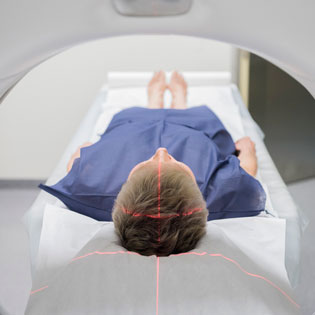
Knock, Knock, Knock. Pause. Knock, Knock, Knock. Banging from different directions, as if you are in the middle of a building site. The droning sound becomes louder and louder. The earplugs and headphones do little to drown out the cacophony. I wonder what people think about inside a MRI tunnel. I lie perfectly still, thinking about how these fascinating machines operate, about the radiographer sitting in the next room and what exactly he does. I think about how a human body – and specifically the protons of its hydrogen molecules – interact and communicate with the MRI scanner and its powerful magnetic field.
It is part of the law of physics that opposites attract. When applied to people and their relationships, this brings forth the notion of magnetized bodies. The protons in our bodies are like tiny magnets that spin on an axis, creating a magnetic charge. In response to the magnetic field of a MRI machine, the protons align with it. When a radio frequency pulse is introduced, the protons are disrupted and realign with the magnetic field, thus changing direction. When the pulse is switched off, they realign again and return to their original positions. In so doing, they communicate with the MRI by releasing electromagnetic energy. This energy is converted into detailed images of the human body.
MRI scanners have been used to examine how conditions such as post-traumatic stress disorder affect the human brain, leading to suggestions that ‘there may be populations that are especially resilient to the effects of severe trauma’.[1] They have also provided evidence, inter alia, that premorbid intelligence in survivors of moderate to severe head injury ‘may provide a resilience factor against depressed mood and that individuals with low premorbid intelligence may be at greater risk of depression’.[2] More broadly, the operationalization of MRI technology involves a synergistic relationship between individual and environment that mirrors the dynamics of resilience.
At its core, resilience is not just about individuals, but about individuals engaging with their environment and harnessing the resources with that environment; and about environments providing the resources necessary for wellbeing and growth. Just as the inter-communication between protons and magnetic fields is essential for diagnosing health conditions in the human body, so too communication and interaction between individuals and their wider ecologies is essential for generating healthy environments that enable positive development and flourishing despite shocks and stressors.
Resilience has often been described as a process of ‘bouncing back’ after adversity.[3] Once the radio frequency pulse is switched off, the neurons realign and assume their original position. It is precisely in doing so, however, that they communicate information to the MRI machine. The concept of ‘bouncing back’ is problematic on a number of levels, and one of the issues is that ‘bouncing back’ – even if it were possible to simply return to a status quo ante after experiencing significant traumas such as conflict-related sexual violence, terrorist attacks and loss of loved-ones – does not occur in isolation. Individuals’ strategies for dealing with the past and rebuilding their lives communicate important information and ‘images’ about their lives and the systems that frame them.
The core aim of CSRS is to reconceptualize transitional justice through an ecological lens, with implications for the field in both theory and practice. Resilience is not about simply ‘bouncing back’ or even about ‘bouncing forward’. The dynamics extend beyond linearity and include crucial elements of expansion and contraction. The data so far, for example, have suggested that individuals who have ‘expanded’ – in the sense of reaching out to others, engaging with their ecologies and making active use of available resources – have higher resilience scores than those who have ‘contracted’ and withdrawn.
Part of the noisiness of a MRI scanner comes from the expansion and contraction of the gradient coils due to changing magnetic fields. In transitional justice, expansion and contraction remain silent concepts. The emphasis is on helping individuals to move forward, not to grow and expand – and not about countering contraction. An ecological reframing of transitional justice means giving more attention to the ecological legacies of war crimes and human rights abuses – and reading the images that these legacies transmit about environments and systems. An ecological widening of the purview of transitional justice is crucial for fostering expansion – and thus resilience – in societies that have experienced war and mass violence.
[1] T. Freeman, T. Kimbrell, L. Booe, M. Myers, D. Cardwell, D.M. Lindquist, J. Hart and R.A. Komoroski, ‘Evidence of resilience: Neuroimaging in former prisoners of war’. Psychiatry Research: Neuroimaging 146/1 (2006): 63.
[2] C.H. Salmond, D.K. Menon, D.A. Chatfield, J.S. Pickard and B.J. Sahakian. ‘Cognitive reserve as a resilience factor against depression after moderate/severe head injury’. Journal of Neurotrauma 23/7 (2006): 1055.
[3] See, for example, G. Windle, ‘What is resilience? A review and concept analysis’. Reviews in Clinical Gerontology 21/2 (2001): 152–169.